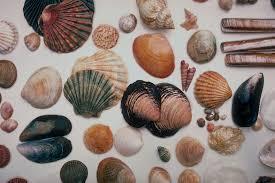Seashells Hold Clues to Stronger Materials
The Department of Energy's Pacific Northwest National Laboratory has identified a key process in the formation of calcium carbonate that could lead to the development of stronger materials for renewable energy research.
January 29, 2016
Anyone who has been to the beach knows how strong some seashells can be, while chalk is a material that’s easy to break and is soft enough to allow for drawing on a blackboard or sidewalk.
Calcium carbonate is a material common to both of these items, and it’s the subject of breakthrough research from the Department of Energy's Pacific Northwest National Laboratory that is providing clues to the development of stronger materials that can be used in the renewable energy field.
Calcium carbonate crystals are hard materials that also include clumps of soft biological matter that make them stronger. The work of the research team, which includes research scientist Jim De Yoreo, is exploring how these clumps use chemical reactions to integrate with atoms in the crystals, providing insight into the formation of natural composite minerals that include both soft and hard components.

Calcium carbonate is a common material found in seashells that contributes to their strength. It’s the subject of new research from the Department of Energy's Pacific Northwest National Laboratory that is providing clues to the development of stronger materials that can be used in the renewable energy field.
(Source: Wikipedia)
The team discovered where the compressive strain of the crystals that makes it harder to disrupt their underlying structure -- the key to the materials’ strength -- comes from. Based on their observations of this process, scientists hope to develop new materials for a sustainable energy future, De Yoreo said.
"This work helps us to sort out how rather weak crystals can form composite materials with remarkable mechanical properties," he said. "It also provides us with ideas for trapping carbon dioxide in useful materials to deal with the excess greenhouse gases we're putting in the atmosphere, or for incorporating light-responsive nanoparticles into highly ordered crystalline matrices for solar energy applications."
[Learn more materials trends and developments at Pacific Design & Manufacturing, Feb. 9-11, at the Anaheim Convention Center.]
Indeed, materials researchers know that calcium carbonate is one of the most important natural materials on earth. It crystalizes into chalk, shells, and rocks, and is used by animals from mollusks to humans to make biominerals such as pearls, seashells, and exoskeletons. All of these biominerals include proteins or other organic matter in the crystalline matrix to change weak calcium carbonate to hard, durable materials.
To determine the geochemical principles of how these biominerals form -- and also how to build synthetic materials with unique properties and in any shape or size -- has been the subject of scientific research for many years. The significance of the latest work from the DoE is that scientists discovered the origin compressive strain that helps make calcium carbonate stronger, providing clues how to replicate this in new materials, De Yoreo said.
Before this work, the leading explanation for how growing crystals incorporate proteins and other particles was based in mechanics. That is, particles land on the flat surface of calcium carbonate as it is crystallizing and the calcium carbonate attaches over and around the particles, trapping them. De Yoreo compared this to a wave washing over a rock, with the crystals moving too fast for the particles to get out of the way.
READ MORE ARTICLES ON BIOMIMICRY:
This explanation, however, lacks details about where the strain within the material comes from. By using atomic force microscopy (AFM), De Yoreo and his team used a high concentration of calcium carbonate that naturally forms a crystalline mineral known as calcite to find the solution, using a several-step, chemistry-driven approach involving introducing organic molecule-based spheres called micelles into the mix.
During the chemical process, the calcium carbonate closed around the micelles and buried them within the crystals, according to researchers. A mathematical simulation showed that the micelles -- or any spherical inclusions -- are compressed like springs as the calcium carbonate enclosed them, creating a strain in the crystal lattice between the micelles that gives it mechanical strength. This strain likely accounts for the added strength seen in seashells, pearls, and similar biominerals, researchers said.
The work will form the basis for new materials research for solar energy at the DoE. The DoE Office of Science and National Institutes of Health provided support for the research.
Elizabeth Montalbano is a freelance writer who has written about technology and culture for more than 15 years. She has lived and worked as a professional journalist in Phoenix, San Francisco, and New York City. In her free time she enjoys surfing, traveling, music, yoga, and cooking. She currently resides in a village on the southwest coast of Portugal.
Like reading Design News? Then have our content delivered to your inbox every day by registering with DesignNews.com and signing up for Design News Daily plus our other e-newsletters. Register here!
About the Author(s)
You May Also Like

.jpg?width=300&auto=webp&quality=80&disable=upscale)

